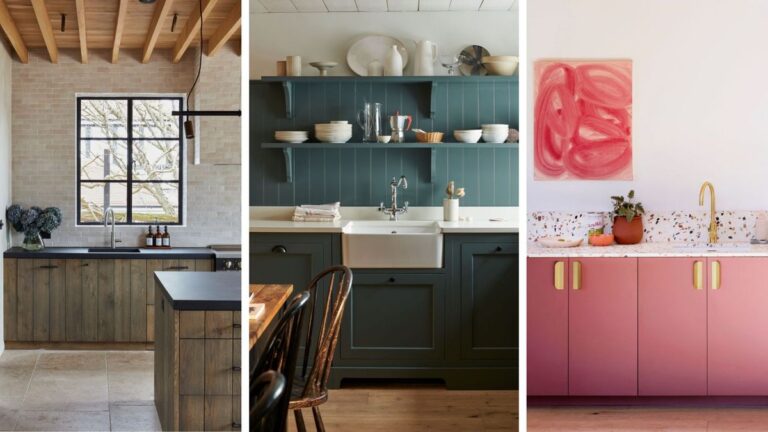The kitchen is often described as the heart of the home, and as cabinets are the most used, visually impressive and expensive part of the kitchen, design choices shouldn't be taken lightly.
Kitchen cabinets can make or break a space, both in terms of appearance and functionality. “When designing a kitchen, choosing the right material for your cabinets is crucial in balancing functionality, durability and aesthetics,” says Allison Kaminski, principal designer at Lola Tucker Interiors.
“The cabinet material you choose will have a huge impact on the overall look and feel of your kitchen, as well as its long-term performance and maintenance requirements,” Allison continues.
But when it comes to choosing cabinet materials, there's no one-size-fits-all answer as to which is best. Your space, the look you want to create, how you use your kitchen, and how long you want to keep it all play a role in determining the best kitchen cabinet material for you. Here are our top 6…
1. Solid wood
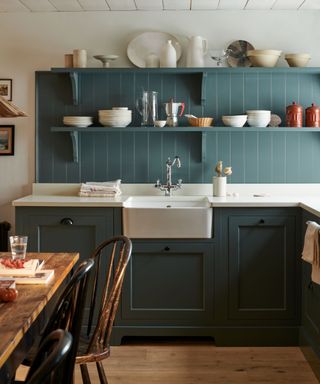
(Image courtesy of Neptune)
Solid wood is a classic material used for kitchen cabinets, and you can't go wrong with it. “Solid wood is a timeless choice, known for its durability and classic look,” says interior designer Rosemarie of Rosemarie Bespoke Designs. “Popular wood species include oak, maple, cherry, and walnut, each with their own unique grain patterns and colors.”
Solid wood cabinets do require some maintenance, so it's important to keep this in mind. “Solid wood is durable, but requires regular maintenance to prevent warping, cracking, and moisture damage,” says Rosemary. “Proper sealing and regular refinishing can significantly extend the lifespan of your wood cabinets.”
If you want your cabinets to match the color of the rest of the room, wood is a great choice as you can paint the cabinets any shade. “Solid wood cabinets are aesthetically versatile because they can be stained or painted to match any kitchen design,” says Rosemary.
But leaving the natural grain intact can give a space its own unique charm. “Solid oak is the quintessential material for kitchen cabinetry, combining form and function,” says Fred Horlock, design director at Neptune. “Oak's natural warmth and rich grain pattern bring an organic feel to any kitchen, making each space unique and distinctive.”
2. Recycled wood
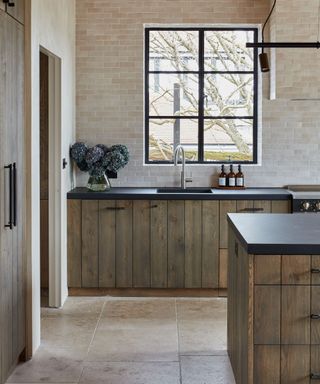
(Image credit: Photo by Chris Snook for The Main Company)
Sustainability and waste are big issues in the interior design industry, and kitchens are no exception. One way to reduce waste is to use reclaimed wood for your kitchen cabinets.
“From Mountain Ridge Parquet to reclaimed Douglas Fir, reclaimed engineered timber is a versatile and dynamic material that offers a range of benefits to your kitchen,” says Alex Main, director of The Main Company.
“By choosing reclaimed wood for your cabinets – which usually come from interesting buildings such as old textile mills, barns or historic buildings – you're giving raw materials a new use, meaning you're utilising resources to create something new that is both sustainable and stylish,” continues Alex.
“No two reclaimed woods are the same, and therefore no two reclaimed kitchens are the same, resulting in a unique space that is different from one another,” says Alex. “The inherent natural character and grain of reclaimed wood adds a traditional, rustic beauty to a kitchen.” Reclaimed wood is also naturally antibacterial, making it easy to care for and ideal for a family kitchen.
Alex points out that reclaimed wood should ideally be engineered, but not many companies do that: “Engineering keeps the wood from warping, shrinking, and splitting like it can with solid wood. So reclaimed engineered wood cabinets look exactly like antique planks, but they have the raised structure of engineered floors.”
3. Plywood
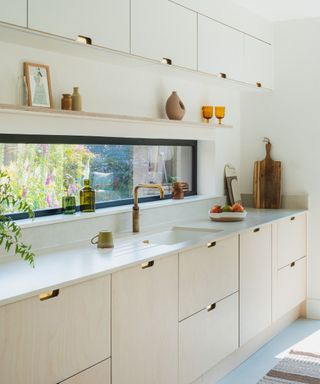
(Image courtesy of Husk)
Plywood is often used for kitchen cabinets because of its strength, stability, and affordability.
“Plywood is durable and can withstand heavy use without warping or cracking, and it's also extremely resistant to moisture, which is crucial in a busy kitchen,” says Jim Leach, founder of Wood & Wire.
But what exactly is plywood? “Plywood is an engineered wood product made by laminating thin veneers and gluing them together with alternating grain to increase durability and reduce the risk of warping,” says Allison Kaminski.
“Plywood's primary advantage is its strength and stability. This robustness allows plywood cabinets to withstand frequent opening and closing, exposure to moisture, and the weight of heavy kitchen appliances,” says Allison. “The cross-grain structure minimizes expansion and contraction, making it less prone to warping and cracking than solid wood.”
Plywood cabinets can be finished with a variety of veneers and laminates to achieve a variety of looks. They're also easy to repair: “Small scratches and dents can be sanded down and any damaged sections can be replaced,” says Allison.
4.MDF
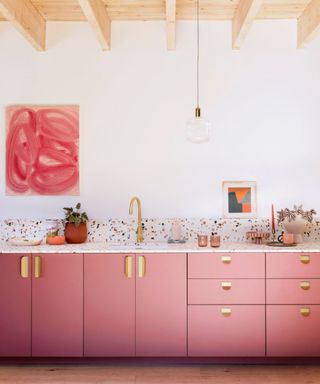
(Image courtesy of Husk)
“Medium density fiberboard (MDF) is an engineered wood material made from compressed wood fibers and resin,” Allison says. “MDF is a cost-effective alternative to solid wood and is widely used for kitchen cabinets because of its smooth surface and ease of customization.”
With a smooth, even surface, MDF is ideal for painting and finishing. “The uniformity allows for a perfect paint finish, making MDF cabinets ideal for achieving a sleek, modern look. Because MDF can be painted any colour, the design possibilities are endless and it's easy to update with changing kitchen trends,” says Alison.
MDF is highly customizable, not just in terms of paint color, but also in terms of shape. “It can be easily cut and shaped to create intricate designs or detailed profiles for cabinet doors. This versatility makes MDF a great choice for both contemporary and traditional kitchen styles, as it can be easily created into any shape,” says Allison.
In terms of durability, MDF is less likely to warp or crack than solid wood because it doesn't have a grain structure. This stability makes MDF a good choice for damp environments such as kitchens.
“Although MDF isn't as durable as solid wood or plywood, its affordability and ease of customization make it a practical and popular choice,” Allison says.
5. Lamination
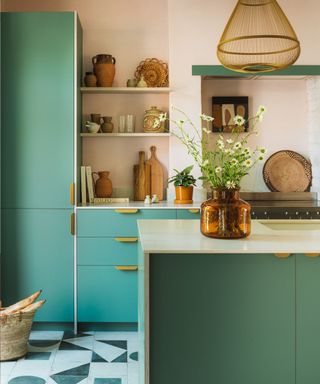
(Image courtesy of Husk)
A cabinet's finish is just as important as its base, and laminate is a popular covering that can add color and texture to the most common MDF or plywood cabinets.
“Laminate is the most popular material for cabinets, and customers love the wide range of colours it's available in, from dark greys to soft pinks and vibrant greens,” says Dave Young, founder of Husk Kitchens. “Laminate's slightly silky, smooth surface reflects light around the room, creating a clean, uncluttered look. It's extremely durable and resistant to scratches and chips, making it ideal for family kitchens,” says Dave.
Laminate is easy to clean, the colors are very durable, and it stands up to stains and sunlight.
“Laminate cabinets are the most common type found in apartments. They are less likely to peel, stain, or scratch,” says Corinne Segura, an InterNACHI-certified healthy home inspector, building biologist, and green building materials consultant. “In all the homes I've inspected, I've never seen a scratch on a laminate cabinet door or front, and they're easy to clean with a sponge and dish soap, or other all-purpose cleaning product.”
6. Stainless steel
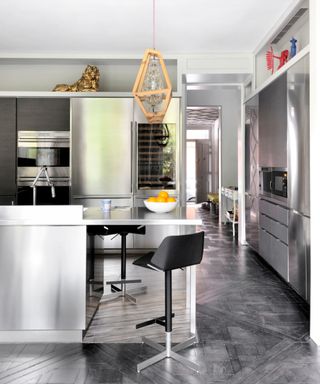
(Image courtesy of Future, Frenchie Cristo Gatin)
Stainless steel kitchens are like Marmite – you either love them or hate them. With a modern, industrial look, they're an instant design feature and conversation piece. But the practical benefits a stainless steel kitchen offers are unmatched – and there's a reason they're found in every professional kitchen.
“Stainless steel is known for its sleek look and exceptional durability, making it a great modern, industrial material for kitchen cabinets,” says Allison.
“It's commonly used in commercial kitchens, but its contemporary look and practical benefits mean it's becoming increasingly popular in residential design as well,” she adds.
One of the main benefits of stainless steel cabinets is their durability: “Stainless steel is extremely resistant to heat, stains and moisture, making it ideal for the rugged environment of a kitchen. It won't warp, crack or chip, providing a long lifespan with minimal effort,” says Allison.
Stainless steel kitchenware is also incredibly easy to clean with just a quick wipe down with wet, soapy water.
Of course, the best material for your kitchen cabinets is a bit subjective and depends on the style you're going for, your budget, and how you'll use your kitchen. While there are many options for cabinet materials, the materials listed above are classics; they've been tried and tested by designers time and time again, so you can be sure they'll last in terms of both quality and style.


